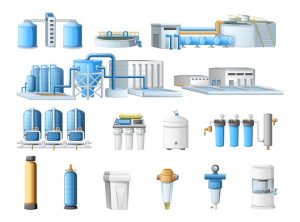A refrigerator water filter is a filter that is installed in the water line that supplies water to the refrigerator. This filter removes impurities from the water, such as chlorine, lead, and sediment.
Different types of fridge water filters:
Refrigerator water filters can also be found in many different brands and models of refrigerators. Many brands such as GE, Samsung, LG, Kenmore, and Whirlpool have their brand of refrigerator water filters.
Refrigerator water filters are also available in many different sizes and styles.
- The most common type of refrigerator water filter is the inline filter. Inline filters are attached to the water line and connected to the refrigerator. Inline filters are typically installed underneath the sink or in the basement.
- Another type of refrigerator water filter is the canister filter. Canister filters are placed in the refrigerator and can be found in the refrigerator’s water compartment. Canister filters are typically replaced every three to six months.
- Some refrigerator water filters are also available in a cartridge filter. Cartridge filters are placed in the refrigerator and can be found in the refrigerator’s water compartment. Cartridge filters are typically replaced every three to six months.
How do fridge water filters work?
Fridge water filters work by removing impurities from the water before it enters the fridge. This includes removing chlorine, lead, and other contaminants that can cause problems with the taste or quality of the water. Some fridge water filters also have a second stage of filtration that removes sediment and other particulates from the water.
This second stage of filtration is important for ensuring that the water dispensed from the fridge is clean and clear. Fridge water filters typically need to be replaced every few months to continue to effectively remove impurities from the water.
Activated carbon technology is used in most refrigerators to absorb contaminants. Activated carbon is a type of carbon that has been treated with oxygen to open up millions of tiny pores between carbon atoms. As water passes over the activated carbon in a refrigerator water filter, the carbon adsorbs (absorbs and adheres) contaminants, such as chlorine, bacteria, and pesticides, from the water.
The activated carbon in a refrigerator water filter typically has a surface area of about 125 acres per pound, with each cubic foot of activated carbon containing over 60 billion pores. Activated carbon also has a strong electro-positive charge. This attracts and traps water-soluble contaminants, as well as particles that are too small to be seen with the naked eye.
Benefits of fridge water filters:
Most refrigerator manufacturers recommend changing your refrigerator water filter every 6 months. The general rule of thumb however is to change your refrigerator water filter every 3-6 months. The best way to ensure you are changing your refrigerator water filter at the proper interval is to keep up with your refrigerator’s maintenance schedule.
Refrigerator water filters remove contaminants and impurities such as Chlorine, Limescale, Rust, Dirt, Sand, Mold, spores, Bacteria, Viruses, Odors, Other toxins, and chemicals.
Refrigerator water filters not only improve the taste and quality of your water, but they also make sure your water is free of harmful contaminants. This protects your family from illness and improves the overall quality of your water.
How to replace fridge water filters?
If you have a refrigerator with a water dispenser or ice maker, chances are it also has a water filter. These filters help to remove impurities from the water, making it safer to drink and improving the taste.
Water filters come in all shapes and sizes, but they all have one thing in common: they need to be replaced regularly. Depending on the type of filter and the severity of the water quality in your area, you may need to replace your fridge water filter every few months or once a year.
When it’s time to replace your fridge water filter, the process is usually pretty simple. Most filters are located in the front of the refrigerator, near the water dispenser or ice maker.
- To replace the filter, simply remove the old one and insert the new one.
- Make sure the arrow on the new filter is pointing in the correct direction, and then screw it in until it’s tight.
- Once the new filter is in place, flush it out by running water through it for a few minutes.
- This will help to remove any contaminants that may have been left behind by the old filter. And that’s it!
By following these simple steps, you can easily replace your fridge water filter and enjoy fresh, clean water whenever you want it.
Are fridge water filters effective?
Yes, fridge water filters are effective at reducing the number of contaminants in your water. However, it is important to note that they will not completely remove all contaminants from your water.
If you are drinking tap water, you will most likely be consuming chlorine. This is because chlorine is used to disinfect tap water during the treatment process. Chlorine can be harmful to your health, so it is important to install a water filter that can remove chlorine from your water.
Some filters are certified to remove other harmful contaminants such as lead, mercury, and copper. These types of filters are usually more expensive than filters that do not have certifications, but they may provide better protection for your health.
It is important to change your water filter regularly to ensure that it is working properly. Most filters need to be replaced every three to six months, but this will vary depending on the type of filter and how often you use it.
If you do not change your filter regularly, it may stop working properly, which can allow contaminants to pass through it and into your water. When you are ready to purchase a water filter, you should compare the different types of filters available and decide which one will work best for you and your family.
You can also read online reviews to see what other customers think about the different types of filters. Make sure to read the instructions carefully and follow the directions on the packaging to ensure that you do not damage your filter.








